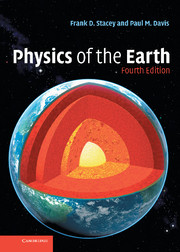Book contents
- Frontmatter
- Contents
- Preface
- 1 Origin and history of the Solar System
- 2 Composition of the Earth
- 3 Radioactivity, isotopes and dating
- 4 Isotopic clues to the age and origin of the Solar System
- 5 Evidence of the Earth's evolutionary history
- 6 Rotation, figure of the Earth and gravity
- 7 Precession, wobble and rotational irregularities
- 8 Tides and the evolution of the lunar orbit
- 9 The satellite geoid, isostasy, post-glacial rebound and mantle viscosity
- 10 Elastic and inelastic properties
- 11 Deformation of the crust: rock mechanics
- 12 Tectonics
- 13 Convective and tectonic stresses
- 14 Kinematics of the earthquake process
- 15 Earthquake dynamics
- 16 Seismic wave propagation
- 17 Seismological determination of Earth structure
- 18 Finite strain and high-pressure equations of state
- 19 Thermal properties
- 20 The surface heat flux
- 21 The global energy budget
- 22 Thermodynamics of convection
- 23 Thermal history
- 24 The geomagnetic field
- 25 Rock magnetism and paleomagnetism
- 26 ‘Alternative’ energy sources and natural climate variations: some geophysical background
- Appendix A General reference data
- Appendix B Orbital dynamics (Kepler's laws)
- Appendix C Spherical harmonic functions
- Appendix D Relationships between elastic moduli of an isotropic solid
- Appendix E Thermodynamic parameters and derivative relationships
- Appendix F An Earth model: mechanical properties
- Appendix G A thermal model of the Earth
- Appendix H Radioactive isotopes
- Appendix I A geologic time scale
- Appendix J Problems
- References
- Name Index
- Subject Index
12 - Tectonics
Published online by Cambridge University Press: 05 July 2013
- Frontmatter
- Contents
- Preface
- 1 Origin and history of the Solar System
- 2 Composition of the Earth
- 3 Radioactivity, isotopes and dating
- 4 Isotopic clues to the age and origin of the Solar System
- 5 Evidence of the Earth's evolutionary history
- 6 Rotation, figure of the Earth and gravity
- 7 Precession, wobble and rotational irregularities
- 8 Tides and the evolution of the lunar orbit
- 9 The satellite geoid, isostasy, post-glacial rebound and mantle viscosity
- 10 Elastic and inelastic properties
- 11 Deformation of the crust: rock mechanics
- 12 Tectonics
- 13 Convective and tectonic stresses
- 14 Kinematics of the earthquake process
- 15 Earthquake dynamics
- 16 Seismic wave propagation
- 17 Seismological determination of Earth structure
- 18 Finite strain and high-pressure equations of state
- 19 Thermal properties
- 20 The surface heat flux
- 21 The global energy budget
- 22 Thermodynamics of convection
- 23 Thermal history
- 24 The geomagnetic field
- 25 Rock magnetism and paleomagnetism
- 26 ‘Alternative’ energy sources and natural climate variations: some geophysical background
- Appendix A General reference data
- Appendix B Orbital dynamics (Kepler's laws)
- Appendix C Spherical harmonic functions
- Appendix D Relationships between elastic moduli of an isotropic solid
- Appendix E Thermodynamic parameters and derivative relationships
- Appendix F An Earth model: mechanical properties
- Appendix G A thermal model of the Earth
- Appendix H Radioactive isotopes
- Appendix I A geologic time scale
- Appendix J Problems
- References
- Name Index
- Subject Index
Summary
Preamble
Seismicity (seismic activity) is a word coined by Gutenberg and Richter (1941) to encompass earthquake occurrences, their mechanisms, magnitudes and especially their geographical distribution. Although we have known for more than 150 years that earthquakes are concentrated in extended, but relatively narrow bands across the Earth (Fig. 12.1), the pattern remained more or less mysterious until it became a cornerstone of the theory of plate tectonics in the 1950s and 1960s. According to this theory the surface of the Earth is divided into almost rigid plates that are in relative motion, with earthquakes occurring mainly at the boundaries. Especially significant in this connection are the deep focus earthquakes, which mark the subduction zones where cooled surface material plunges into the mantle. They provide direct evidence of the deep, convective motion that drives the plates.
There are now more than 3000 globally distributed seismological stations routinely contributing data to the International Seismological Centre at Thatcham, UK. Although they are unevenly distributed, they suffice to locate reliably all earthquakes of magnitude 5 or greater (the definition of magnitude and its relationship to energy are discussed in Section 14.6). By restricting attention to these events we can view the pattern of world seismicity without a bias towards instrumented areas. Earthquake epicentres (Fig. 12.1), that is the surface points directly above the foci (hypocentres) where earthquakes actually occur, outline the plates, which are identified in Fig. 12.2. Intra-plate earthquakes also occur, although much less frequently, demonstrating that the plates are not completely rigid.
- Type
- Chapter
- Information
- Physics of the Earth , pp. 163 - 180Publisher: Cambridge University PressPrint publication year: 2008



